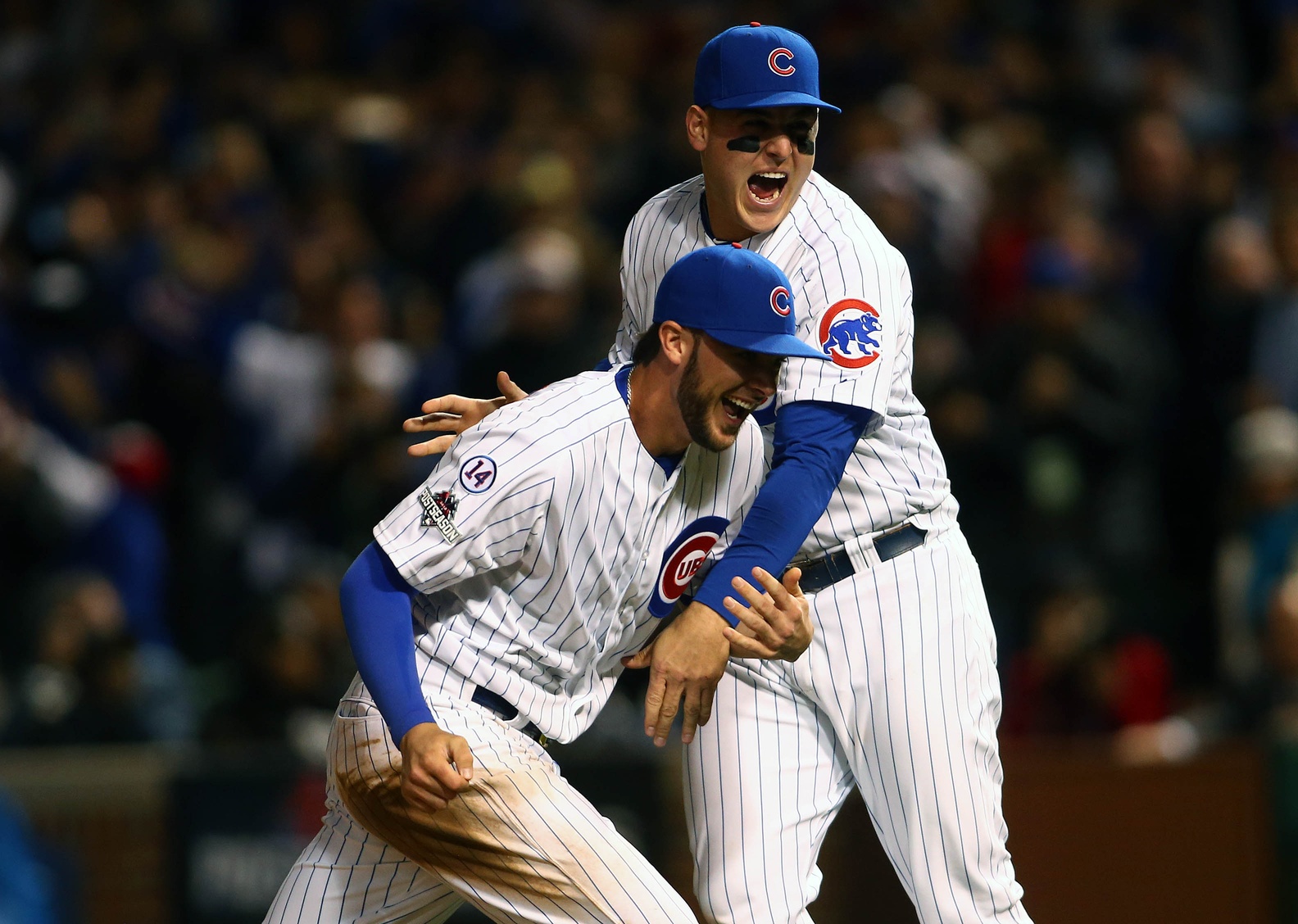For the better part of the past year, the Cubs have been playing up the friendship between Anthony Rizzo and Kris Bryant to the fullest extent possible. In the team’s eyes, the two of them are not just All Star-caliber teammates, but also the key players in MLB’s most compelling bromance. They have become “Bryzzo,” a name that proves that the only people who enjoy the friendship more than Bryant and Rizzo themselves are the fine folks of the Cubs Marketing Department.
The Bryzzo phenomenon has inspired its own hashtag, several GIFs, and a commercial. And already it has proven to be infinitely more successful than the Cubs’ last attempt at a prospect bromance ad:
“Hee-SeoPatterson… Let’s explore Des Moines!”
There’s a lot of reasons to be excited about the “Bryzzo” pairing. Here’s two of them:
1. They will (probably) hit a joyous amount of home runs, and;
2. It’s nearly impossible for Wrigleyville t-shirt vendors to make this Cubs slogan racist.
And one other thing: the bond between the two men might help Bryant learn to emulate Rizzo’s two strike approach.
On the surface, there are many statistical similarities between Bryant and Rizzo’s offensive games. Both are patient hitters with good knowledge of the strike zone who work deep counts and draw plenty of walks. And both make Pat Hughes run to the thesaurus to search for synonyms for “Get out the tape measure.”
Even their 2015 slash lines seem to be having a statistical bromance:
Bryant: .275/.369/.488
Rizzo: .278/.387/.512
If you cast actors to play Bryant and Rizzo’s True Averages, PECOTA projects them to be James Franco and Seth Rogen.
However, there is one major difference that separates the two Cub cornerstones at the plate: contact rate.
Again using their 2015 stats as a point of comparison, Bryant swung at 76.2 percent of pitches he saw in the strike zone, compared to 67.9 percent for Rizzo. However, Rizzo made much more efficient use of those swings, amassing a Z-Contact rate (a contact rate on pitches in the zone) of 92.0 percent. Meanwhile, Bryant’s much more extreme swing and miss tendencies showed up in a much poorer Z-Contact rate of 77.5 percent.
In other words, when Bryant swung at a pitch in the strike zone, he missed it nearly a quarter of the time. In Rizzo’s case, he only missed eight percent of the strikes at which he swung. And at least some of that discrepancy can be explained by their respective approaches with two strikes.
Bryant keeps his hands at the end of the bat to attack with the full force of his vicious uppercut swing and play to his strengths as a power hitter. Last year, the cost of doing so was his league-leading 199 strikeouts.
Meanwhile, Rizzo chokes up on the bat, shortens his stride, and changes his approach to hit the ball where it’s pitched.
(And yes, I realize that the last two paragraphs read like Baseball Prospectus just acquired the rights to Goofus and Gallant. This popular feature will teach valuable lessons like “Hey kids, don’t be like Goofus Bryant! Or you’ll end up signing with Borascorp and getting $6.7 million out of college and winning Rookie of the Year and YOU KNOW WHAT? SCREW IT, GOOFUS, GO AHEAD AND PUT THE DAMN FOIL IN THE MICROWAVE.”)
Famously, Bryant developed his batting stroke under the tutelage of his father, former Red Sox farmhand Mike Bryant, and Mike Bryant in turn based his approach on the hitting philosophies of Ted Williams. But even Williams himself readily admitted that with two strikes, he would look to concede something to the pitcher in order to put the ball in play.
The magnitude of this insight cannot be overstated: shortening up with two strikes is such an important skill that it forced Ted Williams to be modest. Which, as baseball historians will attest, happened about as often as do stories of Ty Cobb charging after a fan in the stands to perform CPR.
Both Len Kasper and Jim Deshaies have noted that this spring that Bryant is trying to cut down on his strikeouts by trying out a more level swing. (Leigh Coridan wrote about that this month.) And this underscores why it’s such good fortune for Anthony Rizzo to be the leader in the Cubs clubhouse, and to have such a good relationship with Bryant. Rizzo has already lived through a career crossroads and made adjustments to his approach in order to become less strikeout-prone. And as the player everyone looks up to, he can provide an effective example to Bryant of the benefits of modifying his swing, as well as dispense encouragement from someone who has done it at the major league level.
If Rizzo’s example can help Bryant adopt a similar approach (tailored to his strengths, of course) and put more balls in play with two strikes, Bryant’s strikeout totals might decrease to a more acceptable amount, and he won’t have to rely on a .378 BABIP to keep his rate stats at All-Star level. Which means those numbers might have a chance to get even better. And there will be no greater sight than the face of a pitcher who realizes he has to speak the word “Bryzzo” in fear.
Lead photo courtesy Jerry Lai—USA Today Sports.

“YOU KNOW WHAT? SCREW IT, GOOFUS, GO AHEAD AND PUT THE DAMN FOIL IN THE MICROWAVE” just cracks me. Thanks for the laugh.
I have fond memories of Goofus and Gallant. This was actually funny. You may have chosen the correct career.